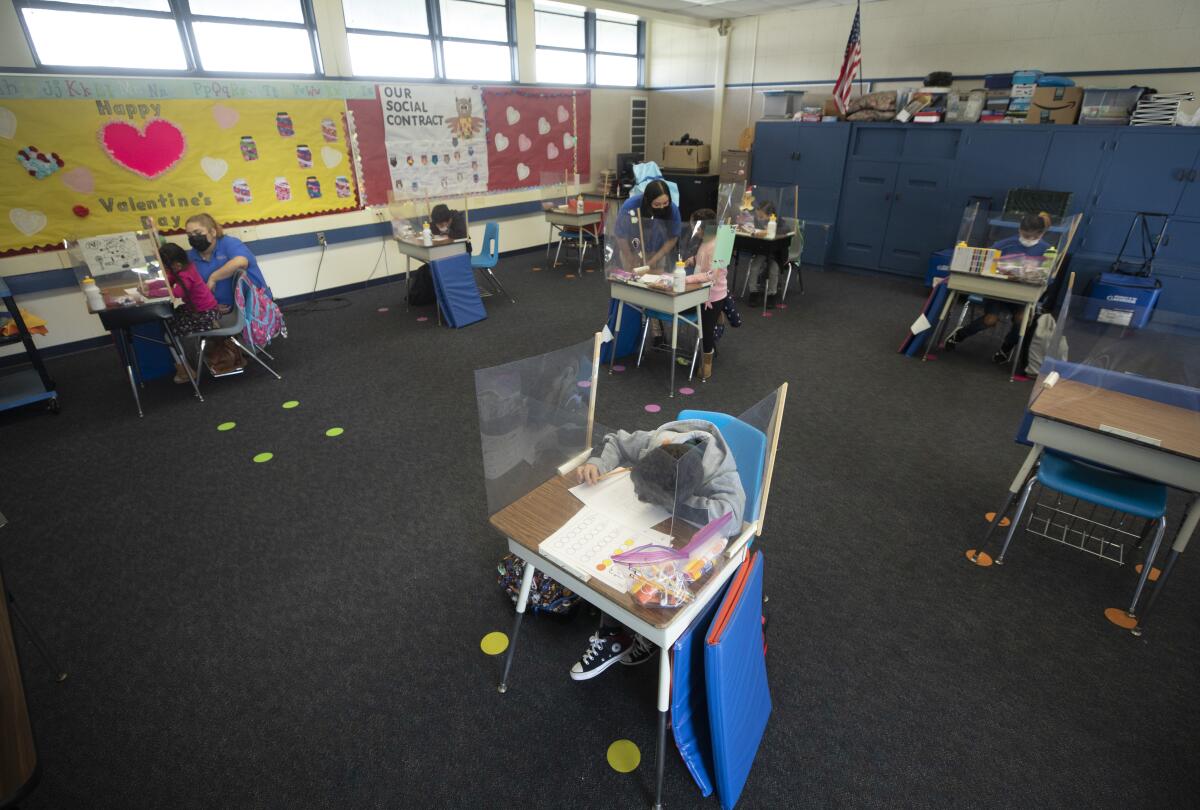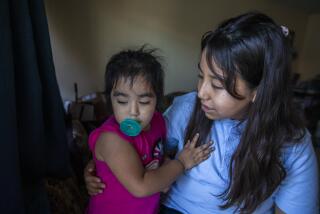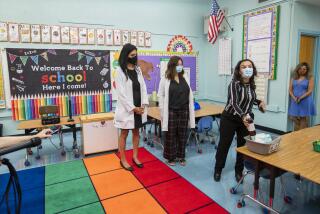We need to reopen schools, but only when it’s safe

- Share via
It has been nearly a year since our children were suddenly exiled from school, and we still have no idea when they can return to actual classrooms.
Since the school shutdown, many of us have discovered the limits of our patience as parents and guardians. For example, I had no idea I was capable of yelling so much. You?
It will be a long time, though, before we fully grasp the effect that school campus closures have had on our kids, a long time before we understand what missing a year of in-classroom instruction and socialization will mean for their long-term academic and emotional development.
It will probably also be a long time before we come to a consensus about whether closing schools, or closing them for this long, was the right thing to do.
Ross Novie, a West Los Angeles father of two public school teenagers, believes he already knows. He says the closures have been disastrous for his family, and he thinks schools need to reopen sooner rather than later.
“We started out with shoes on, sitting at the table, and now it’s devolved to, like, doing school in bed,” he told me. “You’re setting up your own little jail cell.”
Novie, an assistant director on the popular TV show “Superstore,” was able to return to work at Universal after the studio instituted rigorous on-set safety measures. “We have been able to shoot since fall,” he said. “We have had no transmission on set.” He can’t understand why, if the studios have figured out a way to keep people safe, schools can’t do the same.
In December, Novie founded a parent group called the L.A. School Uprising to agitate for reopening. His group is affiliated with Open Schools California, a statewide parent group pushing for schools to resume in-person classes.
“My role is to let parents see they are not alone, because otherwise you can go crazy,” he told me Monday. “You see other places finding ways to do it even a couple days a week.”
He doesn’t understand why the Los Angeles Unified School District can’t do the same.
But, of course, schools are not well-funded studios, and LAUSD, with hundreds of thousands of students and thousands of teachers and staff scattered across more than 1,000 schools, is a different challenge by many orders of magnitude.
The science, ever evolving, seems to indicate that children are not vectors of transmission to adults, and that opening schools could well be the right move. Last week, the Centers for Disease Control and Prevention concluded, in an article published in the Journal of the American Medical Assn., that “there has been little evidence that schools have contributed meaningfully to increased community transmission.”
Los Angeles Unified schools have been working ever since March to make campuses safer — with better air filtration in classrooms and staff training on “the three S’s” — sanitation, screening and social distancing and the introduction of an app that will generate a QR code to serve as a daily pass for students and staff.
And now, Gov. Gavin Newsom has proposed a much-criticized plan that would allow California school districts to apply for waivers to reopen if their community rates of infection fall below a certain threshold. It goes without saying that in Los Angeles County, these rules would benefit private schools and richer, whiter districts, since communities of color are often in areas more densely populated than suburbs, have lower incomes and have been hit harder by COVID-19.
On Monday, Los Angeles School Supt. Austin Beutner called the plan to allow the granting of waivers “bass ackwards.”
“That’s not born in science,” Beutner told my colleague Howard Blume. “That’s political…. Our goal has to be to get COVID down where we can start having all students back.”
This makes sense to me.
Among some parents, it has become fashionable to blame the United Teachers Los Angeles for the continuing closures. But teachers have struggled, too, and their union would like nothing more than to have them back in the classroom, but not until it’s safe.
“What gets me,” said an LAUSD administrator who asked not to be named in order to talk freely without having to get the district’s permission, “and what’s in the ether, is this idea that in L.A. in particular, we don’t want to reopen. And that could not be further from the truth. We are in the epicenter of the virus right now. I think teachers are working harder now. It’s mentally draining for them. It’s a different kind of exhausting.”
I can see this every day, as I hear my fifth-grader’s teachers cajoling students, asking them to turn their cameras on, to please participate.
My 10-year-old is one of the few, lucky kids who seems to be thriving in Zoom school. The administrator with whom I spoke estimated that perhaps 10% to 15% of schoolchildren are actually doing better than they might have in a classroom. In our case, I think my girl’s social butterfly tendencies have been thwarted, and she is better able to focus on lessons (though not always). Lately, she’s been so into school that last week, she came downstairs and put a sticky note on my laptop while I was in the middle of a work call. “Can you Pls not lagh so much,” her note read. “I am in school.”
I am prepared — and you should be too — for our school campuses to be closed the rest of the school year — though I hope I’m wrong. (And please, people, get vaccinated as soon as it’s your turn so we can knock back the virus and reopen schools sooner.)
But until campuses reopen, I am working on my patience, my tone of voice. And I am trying, without success, to stop laghing so much.
@AbcarianLAT
More to Read
A cure for the common opinion
Get thought-provoking perspectives with our weekly newsletter.
You may occasionally receive promotional content from the Los Angeles Times.










